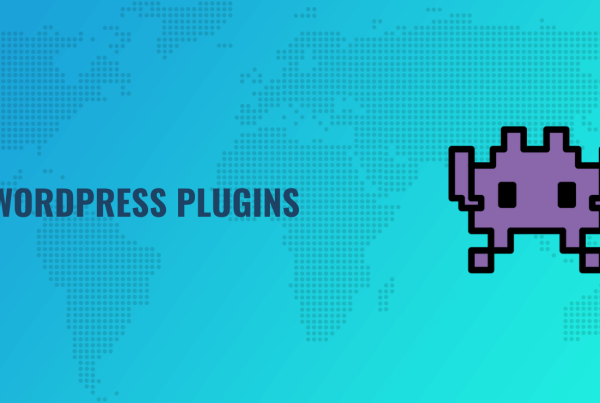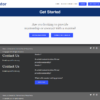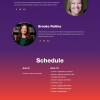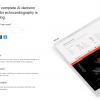Hey there, WordPress fans. We’re checking in with the latest WordPress news and updates in our February 2019 edition of The WordPress Update.
If you’re not already familiar with The WordPress Update, it’s our monthly WordPress news roundup where we share everything that’s happening in the WordPress community, as well as our thoughts on the latest stories. Then, we post it here on the blog and send it out to our newsletter subscribers.
If you want to stay on top of the latest WordPress news and make sure you get all the future versions of The WordPress Update, the best thing to do is to sign up for the newsletter.
This month, we got a new major WordPress version – WordPress 5.1. While there are no sexy new front-end features, WordPress 5.1 brings some great functionality to keep your site healthy and functioning.
Beyond that, the Gutenberg team keeps expanding and improving on the WordPress block editor, and you’ll soon be able to use a stripped-down version of the block editor on your mobile devices.
Let’s get to all the latest WordPress news from February 2019…
WordPress 5.1 is out!
On February 21, WordPress 5.1 “Betty” was officially released to the public. Named for Betty Carter, this release is mostly focused on helping you create a healthy WordPress site with several new features.
First off, you get new features in the Site Health project.
One such feature is “fatal error protection”, which will help prevent you from accidentally White Screen of Death’ing your WordPress site. WordPress will now recognize when a fatal error occurs and which plugin is causing it. It will then pause this extension on the backend so that you can still log into your WordPress dashboard and fix the issue.
Beyond that, WordPress 5.1 also includes features to help with PHP version compatibility. Your dashboard will now show a notice if you’re running an outdated version of PHP (under PHP 5.6), and WordPress 5.1 will also honor plugin PHP version requirements by displaying a warning for plugins that require a higher PHP version than the one running on your server.
On a side note, there are lots of benefits to upgrading to the latest versions of PHP – like performance and security – so we highly recommend looking into this for your site.
Beyond the Site Health features, WordPress 5.1 also further improves performance in the block editor, so the editor should load a little quicker and typing should feel smoother for you.
Gutenberg 5.1 brings widgets as blocks (and better performance)
Not to be confused with WordPress 5.1, Gutenberg 5.1 is also out with some changes and improvements to the block editor.
Note: Despite the identical version numbers, the Gutenberg 5.1 changes are not part of WordPress 5.1 yet, but will be rolled into the core at some point in the future – most likely the next major release.
The biggest change is that now all WordPress widgets have officially been ported into Gutenberg blocks (well, all the widgets that the core team plans on porting to blocks, specifically).
Next, the core team needs to figure out how to adjust the widgets screen to reflect the shift to blocks.
Beyond the widget changes, Gutenberg 5.1 also adds some micro-animations to offer a smoother experience while working in the editor, and it also brings further performance improvements to the editor, especially for large posts.
You can see a summary of how performance has changed over the different versions (note that WordPress 5.1 is running Gutenberg 4.8, not Gutenberg 5.1):
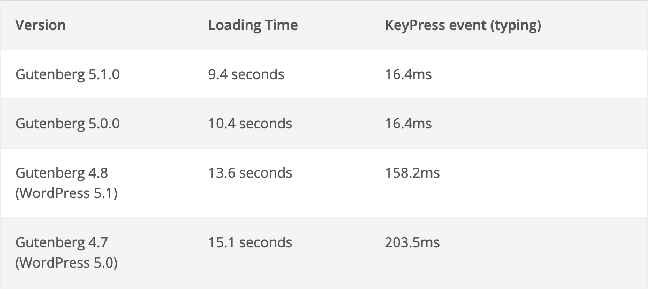
To learn more, you can give this WP Tavern article a read. And if you want to try the Gutenberg 5.1 features right now, you can skip the wait and install the Gutenberg plugin to access them right away.
Beta block editor for WordPress mobile apps
One of the odd things about the new block editor rollout is that, at the time of release, the block editor only worked on desktop sites. That is, you couldn’t use the block editor in the WordPress mobile apps.
That’s going to change…soon.
Specifically, the block editor is now in beta testing on the WordPress mobile apps.
However, the first version will not be a full 1:1 port. Instead, it will focus on supporting the Paragraph, Image, and Heading blocks. According to Jorge Bernal, 90%+ of the posts that people create on mobile consist of just text and images (which makes sense – you probably don’t want to get into detailed formatting on a mobile app).

Additionally, you’ll still be able to access and use the classic editor on mobile apps. If you edit a post, the app will automatically detect whether it’s using the block or classic editor, and you’ll also be able to switch between the two on the fly.
To learn more, you can check out Jorge’s release post at WordPress.org.
New block management features proposed for WordPress 5.2
To extend the WordPress block editor, hundreds of enterprising developers are creating their own plugins that add new blocks for you to use in the editor.
That’s great because it gives you more control over the content that you create with the block editor. But at the same time, it can also mean that the block editor interface gets pretty crowded.
See, most block plugin developers include 10+ blocks in a single plugin. So if you only need one of those blocks, you’re still going to have the other nine blocks cluttering up the block editor interface.
To help fix that, one proposed feature for the next major release – WordPress 5.2 – is a block management feature. Specifically, the ability for users to turn off or hide blocks that they aren’t using.
Block management is not officially part of the WordPress 5.2 roadmap yet, but it’s definitely going to be a pain point for users as developers release more block plugins (and as the core team replaces widgets with blocks).
WP Tavern has more on the story.
If you don’t want to wait around for block management in the core, there are already some plugins that add block management functionality. Good options to start you off are:
WordPress 5.2 proposed schedule and scope
Beyond the proposed block management feature above, Gary Pendergast also shared more about the scope and schedule for WordPress 5.2 in this post at WordPress.org.
First, there’s the schedule…
The core team is hoping to have a beta ready for the middle of March. Then, the proposed release date is set for April 23, 2019.
So what can you expect from WordPress 5.2?
The biggest features will probably be with Gutenberg/the block editor. All those features I shared in Gutenberg 5.1 – widgets as blocks, improved performance, etc. – should be ready to merge into the core in WordPress 5.2.
Beyond that, the core team believes that the Health Check plugin should be ready to merge into the core, as well. If you haven’t played around with the Health Check & Troubleshooting plugin, it basically adds a bunch of checks to your WordPress site to catch common configuration errors and other issues.
Then, it also shares debug information to help you (or the support staff you’re working with) fix the issue.
If you don’t want to wait until WordPress 5.2 to try either of these features, you can install both the Health Check & Troubleshooting and Gutenberg plugins to get access right away.
WordPress 5.0.0 Remote Code Execution Explained
First off, it’s important to note that this core vulnerability was patched in WordPress 4.9.9 and 5.0.1, so don’t worry that your site is automatically at risk!
However, this post from RIPS Tech offers an interesting (though heavily technical) explanation of what was happening with the vulnerability.
Wordfence launches a central security dashboard
Speaking of WordPress security, Wordfence recently launched a new feature called Wordfence Central that should be of interest to you if you manage multiple WordPress sites.
This free tool gives you a single interface where you can manage security issues for all your WordPress sites (assuming they’re running the Wordfence plugin, of course).
If you do decide to use Wordfence Central, we (and the Wordfence team) highly recommend that you take advantage of Wordfence Central’s two-factor authentication feature to keep your account secure. If someone were to get access to your Wordfence Central account, they could change security configurations on all your sites. So – use a strong password and lock it down with two-factor authentication!
And that wraps up all of the most important WordPress news and articles from February 2019.
Make sure to subscribe to the newsletter by using the box below. And also check back next month for all the exciting news that’s bound to drop in March.




